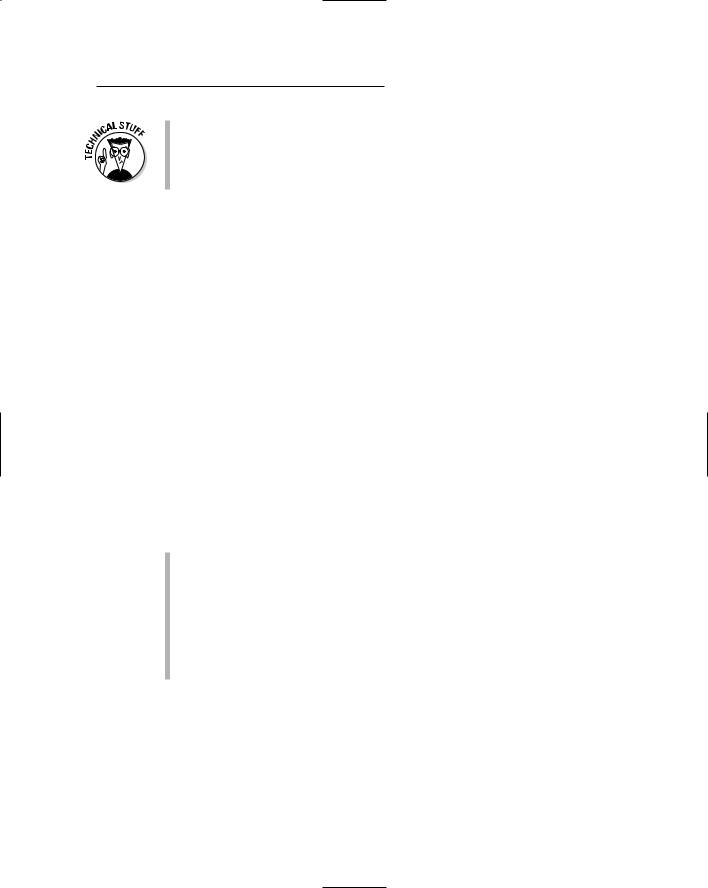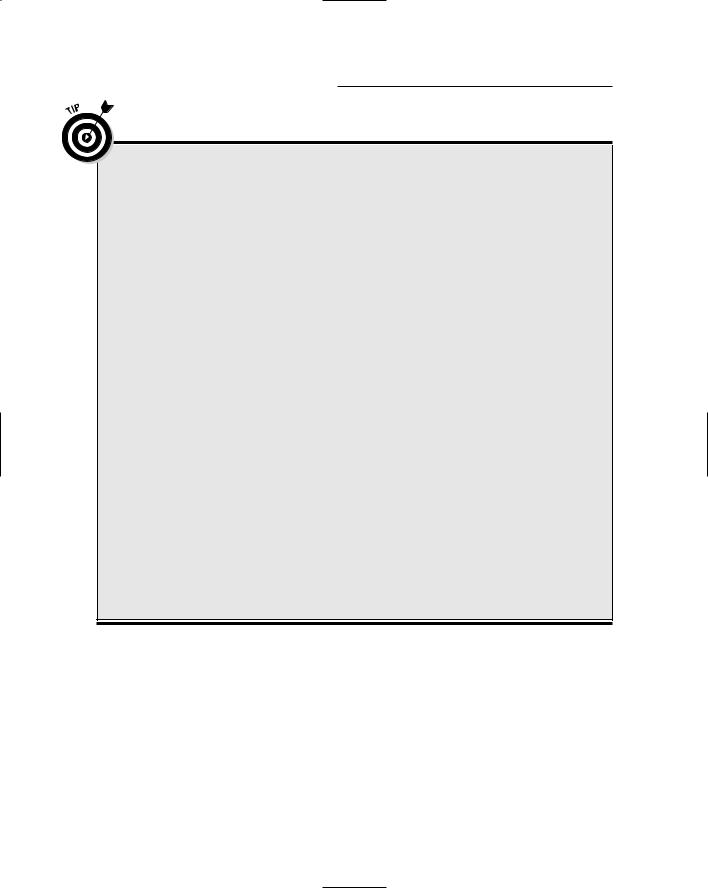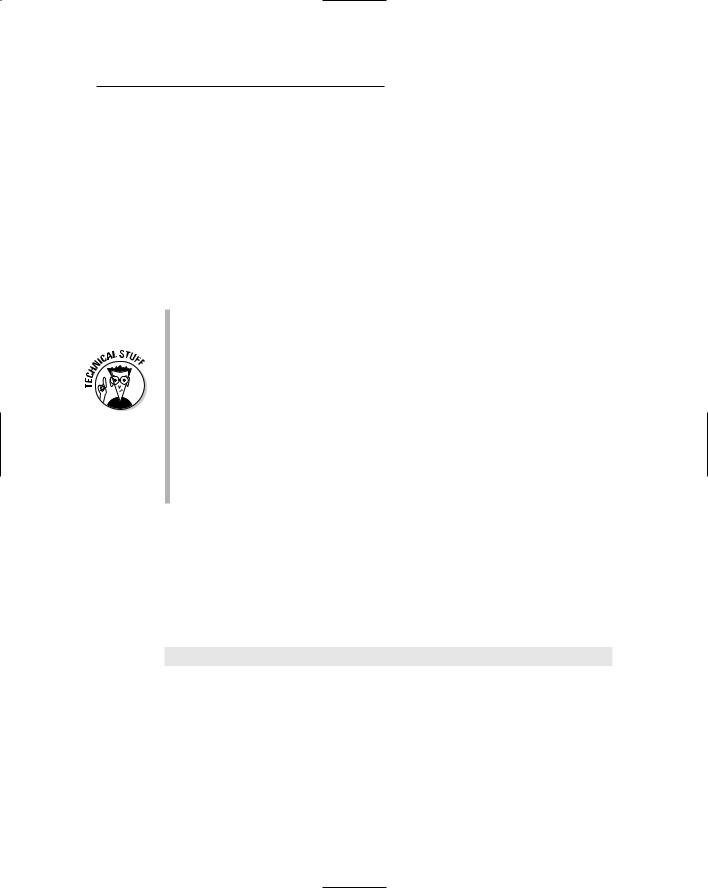
- •Table of Contents
- •Introduction
- •About This Here Dummies Approach
- •How to Work the Examples in This Book
- •Foolish Assumptions
- •Icons Used in This Book
- •Final Thots
- •The C Development Cycle
- •From Text File to Program
- •The source code (text file)
- •The compiler and the linker
- •Running the final result
- •Save It! Compile and Link It! Run It!
- •Reediting your source code file
- •Dealing with the Heartbreak of Errors
- •The autopsy
- •Repairing the malodorous program
- •Now try this error!
- •The Big Picture
- •Other C Language Components
- •Pop Quiz!
- •The Helpful RULES Program
- •The importance of being \n
- •Breaking up lines\ is easy to do
- •The reward
- •More on printf()
- •Printing funky text
- •Escape from printf()!
- •A bit of justification
- •Putting scanf together
- •The miracle of scanf()
- •Experimentation time!
- •Adding Comments
- •A big, hairy program with comments
- •Why are comments necessary?
- •Bizarr-o comments
- •C++ comments
- •Using Comments to Disable
- •The More I Want, the More I gets()
- •Another completely rude program example
- •And now, the bad news about gets()
- •The Virtues of puts()
- •Another silly command-prompt program
- •puts() and gets() in action
- •More insults
- •puts() can print variables
- •The Ever-Changing Variable
- •Strings change
- •Running the KITTY
- •Hello, integer
- •Using an integer variable in the Methuselah program
- •Assigning values to numeric variables
- •Entering numeric values from the keyboard
- •The atoi() function
- •So how old is this Methuselah guy, anyway?
- •Basic mathematical symbols
- •How much longer do you have to live to break the Methuselah record?
- •The direct result
- •Variable names verboten and not
- •Presetting variable values
- •The old random-sampler variable program
- •Maybe you want to chance two pints?
- •Multiple declarations
- •Constants and Variables
- •Dreaming up and defining constants
- •The handy shortcut
- •The #define directive
- •Real, live constant variables
- •Numbers in C
- •Why use integers? Why not just make every number floating-point?
- •Integer types (short, long, wide, fat, and so on)
- •How to Make a Number Float
- •The E notation stuff
- •Single-character variables
- •Char in action
- •Stuffing characters into character variables
- •Reading and Writing Single Characters
- •The getchar() function
- •The putchar() function
- •Character Variables As Values
- •Unhappily incrementing your weight
- •Bonus program! (One that may even have a purpose in life)
- •The Sacred Order of Precedence
- •A problem from the pages of the dentistry final exam
- •The confounding magic-pellets problem
- •Using parentheses to mess up the order of precedence
- •The computer-genie program example
- •The if keyword, up close and impersonal
- •A question of formatting the if statement
- •The final solution to the income-tax problem
- •Covering all the possibilities with else
- •The if format with else
- •The strange case of else-if and even more decisions
- •Bonus program! The really, really smart genie
- •The World of if without Values
- •The problem with getchar()
- •Meanwhile, back to the GREATER problem
- •Another, bolder example
- •Exposing Flaws in logic
- •A solution (but not the best one)
- •A better solution, using logic
- •A logical AND program for you
- •For Going Loopy
- •For doing things over and over, use the for keyword
- •Having fun whilst counting to 100
- •Beware of infinite loops!
- •Breaking out of a loop
- •The break keyword
- •The Art of Incrementation
- •O, to count backward
- •How counting backward fits into the for loop
- •More Incrementation Madness
- •Leaping loops!
- •Counting to 1,000 by fives
- •Cryptic C operator symbols, Volume III: The madness continues
- •The answers
- •The Lowdown on while Loops
- •Whiling away the hours
- •Deciding between a while loop and a for loop
- •Replacing those unsightly for(;;) loops with elegant while loops
- •C from the inside out
- •The Down-Low on Upside-Down do-while Loops
- •The devil made me do-while it!
- •do-while details
- •The always kosher number-checking do-while loop
- •Break the Brave and Continue the Fool
- •The continue keyword
- •The Sneaky switch-case Loops
- •The switch-case Solution to the LOBBY Program
- •The Old switch-case Trick
- •The Special Relationship between while and switch-case
- •A potentially redundant program in need of a function
- •The noble jerk() function
- •Prototyping Your Functions
- •Prototypical prototyping problems
- •A sneaky way to avoid prototyping problems
- •The Tao of Functions
- •The function format
- •How to name your functions
- •Adding some important tension
- •Making a global variable
- •An example of a global variable in a real, live program
- •Marching a Value Off to a Function
- •How to send a value to a function
- •Avoiding variable confusion (must reading)
- •Functions That Return Stuff
- •Something for your troubles
- •Finally, the computer tells you how smart it thinks you are
- •Return to sender with the return keyword
- •Now you can understand the main() function
- •Give that human a bonus!
- •Writing your own dot-H file
- •A final warning about header files
- •What the #defines Are Up To
- •Avoiding the Topic of Macros
- •A Quick Review of printf()
- •The printf() Escape Sequences
- •The printf() escape-sequence testing program deluxe
- •Putting PRINTFUN to the test
- •The Complex printf() Format
- •The printf() Conversion Characters
- •More on Math
- •Taking your math problems to a higher power
- •Putting pow() into use
- •Rooting out the root
- •Strange Math? You Got It!
- •Something Really Odd to End Your Day
- •The perils of using a++
- •Oh, and the same thing applies to a --
- •Reflections on the strange ++a phenomenon
- •On Being Random
- •Using the rand() function
- •Planting a random-number seed
- •Randoming up the RANDOM program
- •Streamlining the randomizer
- •Arrays
- •Strings
- •Structures
- •Pointers
- •Linked Lists
- •Binary Operators
- •Interacting with the Command Line
- •Disk Access
- •Interacting with the Operating System
- •Building Big Programs
- •Use the Command-Line History
- •Use a Context-Colored Text Editor
- •Carefully Name Your Variables
- •Breaking Out of a Loop
- •Work on One Thing at a Time
- •Break Up Your Code
- •Simplify
- •Talk through the Program
- •Set Breakpoints
- •Monitor Your Variables
- •Document Your Work
- •Use Debugging Tools
- •Use a C Optimizer
- •Read More Books!
- •Setting Things Up
- •The C language compiler
- •The place to put your stuff
- •Making Programs
- •Finding your learn directory or folder
- •Running an editor
- •Compiling and linking
- •Index

Chapter 1: Up from the Primordial C |
11 |
The guy who created the C programming language at Bell Labs is Dennis Ritchie. I mention him in case you’re ever walking on the street and you happen to bump into Mr. Ritchie. In that case, you can say “Hey, aren’t you Dennis Ritchie, the guy who invented C?” And he’ll say “Why — why, yes I am.” And you can say “Cool.”
The C Development Cycle
Here is how you create a C program in seven steps — in what’s known as the development cycle:
1.Come up with an idea for a program.
2.Use an editor to write the source code.
3.Compile the source code and link the program by using the C compiler.
4.Weep bitterly over errors (optional).
5.Run the program and test it.
6.Pull out hair over bugs (optional).
7.Start over (required).
No need to memorize this list. It’s like the instructions on a shampoo bottle, though you don’t have to be naked and wet to program a computer. Eventually, just like shampooing, you start following these steps without thinking about it. No need to memorize anything.
The C development cycle is not an exercise device. In fact, program ming does more to make your butt fit more snugly into your chair than anything.
Step 1 is the hardest. The rest fall naturally into place.
Step 3 consists of two steps: compiling and linking. For most of this book, however, they are done together, in one step. Only later — if you’re still interested — do I go into the specific differences of a compiler and a linker.
From Text File to Program
When you create a program, you become a programmer. Your friends or rela tives may refer to you as a “computer wizard” or “guru,” but trust me when I say that programmer is a far better title.

12 |
Part I: Introduction to C Programming |
As a programmer, you job is not “programming.” No, the act of writing a pro gram is coding. So what you do when you sit down to write that program is code the program. Get used to that term! It’s very trendy.
The job of the programmer is to write some code! Code to do what? And what type of code do you use? Secret code? Morse Code? Zip code?
The purpose of a computer program is to make the computer do something.
The object of programming is to “make it happen.” The C language is only a tool for communicating with the PC. As the programmer, it’s your job to trans late the intentions of the computer user into something the computer under stands and then give users what they want. And if you can’t give them what they want, at least make it close enough so that they don’t constantly com plain or — worse — want their money back.
The tool you have chosen to make it happen is the C programming language. That’s the code you use to communicate with the PC. The following sections describe how the process works. After all, you can just pick up the mouse and say “Hello, computer!”
Programming is what TV network executives do. Computer programmers code.
You use a programming language to communicate with the computer, telling it exactly what to do.
The source code (text file)
Because the computer can’t understand speech and, well, whacking the computer — no matter how emotionally validating that is for you — does little to the PC, your best line of communications is to write the computer a note — a file on disk.
To create a PC epistle, you use a program called a text editor. This program is a primitive version of a word processor minus all the fancy formatting and print ing controls. The text editor lets you type text — that’s about all.
Using your text editor, you create what’s called a source code file. The only spe cial thing about this file is that it contains instructions that tell the computer what to do. And although it would be nice to write instructions like “Make a funny noise,” the truth is that you must write instructions in a tongue the com puter understands. In this case, the instructions are written in the C language.

Chapter 1: Up from the Primordial C |
13 |
The source code file is a text file on disk. The file contains instructions for the computer that are written in the C programming language.
You use a text editor to create the source code file. See Appendix A for more information on text editors.
Creating the GOODBYE.C source code file
Use your text editor to create the following source code. Carefully type each line exactly as written; everything you see below is important and necessary. Don’t leave anything out:
#include <stdio.h>
int main()
{
printf(“Goodbye, cruel world!\n”); return(0);
}
As you review what you have typed, note how much of it is familiar to you. You recognize some words (include, main, “Goodbye, cruel world!”, and return), and some words look strange to you (stdio.h, printf, and that \n thing).
When you have finished writing the instructions, save them in a file on disk. Name the file GOODBYE.C. Use the commands in your text editor to save this file, and then return to the command prompt to compile your instructions into a program.
See Appendix A for information on using a text editor to write C language programs as well as for instructions on where you should save the source code file on disk.
In Windows Notepad, you must ensure that the file ends in .C and not in
.TXT. Find a book about Windows for instructions on showing the file name extensions, which makes saving a text file to disk with a .C exten sion easier.
Note that the text is mostly in lowercase. It must be; programming lan guages are more than case sensitive — they’re case-fussy. Don’t worry when English grammar or punctuation rules go wacky; C is a computer language, not English.
Also note how the program makes use of various parentheses: the angle brackets, < and >; the curly braces, { and }; and the regular parentheses, ( and ).

14 |
Part I: Introduction to C Programming |
Extra help in typing the GOODBYE.C source code
The first line looks like this:
#include <stdio.h>
Type a pound sign (press Shift+#) and then include and a space. Type a left angle bracket (it’s above the comma key) and then stdio, a period, h, and a right angle bracket. Everything must be in lowercase — no capitals! Press Enter to end this line and start the second line.
Press the Enter key alone on the second line to make it blank. Blank lines are common in pro gramming code; they add space that separates pieces of the code and makes it more readable. And, trust me, anything that makes program ming code more readable is okay by me!
Type the word int, a space, main, and then two parentheses hugging nothing:
int main()
There is no space between main and the parentheses and no space inside the parenthe ses. Press Enter to start the fourth line.
Type a left curly brace:
{
This character is on a line by itself, right at the start of the line. Press Enter to start the fifth line.
printf(“Goodbye, cruel world!\n”);
If your editor was smart enough to automati cally indent this line, great. If not, press the Tab key to indent. Then type printf, the word print with a little f at the end. (It’s pronounced “print eff.”) Type a left parenthesis. Type a double quote. Type Goodbye, cruel world, followed by an exclamation point. Then type a backslash, a little n, double quotes, a right parenthesis, and, finally, a semicolon. Press Enter to start the sixth line.
return(0);
If the editor doesn’t automatically indent the sixth line, press the Tab key to start the line with an indent. Then type return, a paren, 0 (zero), a paren, and a semicolon. Press Enter.
On the seventh line, type the right curly brace:
}
Some editors automatically unindent this brace for you. If not, use your editor to back up the brace so that it’s in the first column. Press the Enter key to end this line.
Leave the eighth line blank.
The compiler and the linker
After the source code is created and saved to disk, it must be translated into a language the computer can understand. This job is tackled by the compiler.
The compiler is a special program that reads the instructions stored in the source code file, examines each instruction, and then translates the information into the machine code understood only by the computer’s microprocessor.

Chapter 1: Up from the Primordial C |
15 |
If all goes well and the compiler is duly pleased with your source code, the compiler creates an object code file. It’s a middle step, one that isn’t necessary for smaller programs but that becomes vital for larger programs.
Finally, the compiler links the object code file, which creates a real, live com puter program.
If either the compiler or the linker doesn’t understand something, an error message is displayed. At that point, you can gnash your teeth and sit and stew. Then go back and edit the source code file again, fixing whatever error the compiler found. (It isn’t as tough as it sounds.) Then you attempt to compile the program again — you recompile and relink.
The compiler translates the information in the source code file into instruc tions the computer can understand. The linker then converts that infor mation into a runnable program.
The GCC compiler recommended and used in this book combines the compiling and linking steps. An object file is created by GCC, but it is automatically deleted when the final program file is created.
Object code files end in OBJ or sometimes just O. The first part of the object file name is the same as the source code filename.
Feel free to cheerfully forget all this object code nonsense for now.
Text editor Compiler.
Source code Program.
Compiling GOODBYE.C
The gritty details for compiling a program are in Appendix A. Assuming that you have thumbed through it already, use your powerful human memory to recall the proper command to compile and link the GOODBYE.C source code. Here’s a hint:
gcc goodbye.c -o goodbye
Type that command at your command prompt and see what happens.
Well?
Nothing happens! If you have done everything properly, the GCC compiler merely creates the final program file for you. The only time you see a mes sage is if you goof up and an error occurs in the program.
